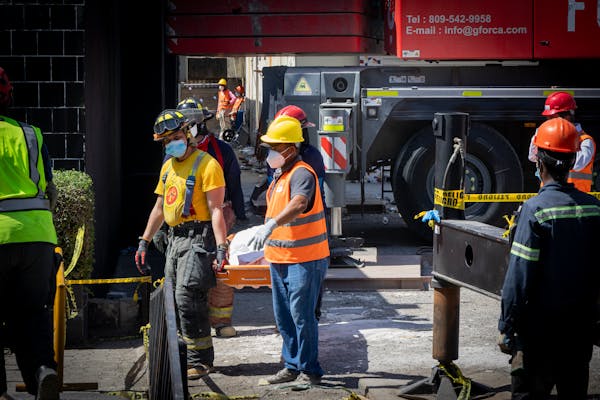Workplace safety risks can significantly impact productivity and employee well-being. Custom solutions offer a proactive approach to identifying and addressing these risks effectively. From flexible document collaboration to robust E-learning tools, tailored strategies enhance compliance and empower employees. Explore innovative methods that not only mitigate hazards but also foster a culture of safety across diverse industries, ensuring operational integrity and trust in your organization.
Identifying Workplace Safety Risks
Conducting a workplace hazards assessment is foundational in creating a safer workplace. Ensuring employee protection starts with recognizing potential risks and acting promptly. For instance, slips, trips, falls, exposure to hazardous substances, and machinery-related injuries are common issues across industries. A thorough evaluation allows businesses to uncover often overlooked danger zones that could lead to severe consequences. As stated in the health and safety executive news, staying updated on regulatory changes and safety practices is critical for keeping risks under control.
This might interest you : Unlocking UK Business Potential: Supercharge Marketing with Geofencing Strategies for Local Growth
Importance of Risk Assessments
Thorough risk assessments minimize uncertainties. They identify specific hazards in workflows, equipment, and environments, offering opportunities for preventative measures. Tools like job hazard analysis techniques, ergonomic assessments, and comprehensive safety audits ensure a proactive approach. By systematically assessing potential threats, businesses can better align their safety strategies with operational goals, reducing accidents and ensuring compliance.
Tools and Strategies for Hazard Identification
Modern technology complements traditional methods of identifying workplace hazards. Safety management software, real-time reporting systems, and mobile safety applications streamline data collection and analysis. These tools simplify monitoring and incident documentation while promoting effective communication. Additionally, fostering a safety-first mindset through interactive training modules and tailored programs ensures both awareness and accountability among employees.
Have you seen this : Key Considerations for UK Businesses Crafting Effective Remote Work Policies
Custom Solutions for Workplace Safety
Tailored Safety Products and PPE
Customizing safety products like personal protective equipment (PPE) and workplace signage is a proactive way to address industry-specific safety risks. Such tools can be adapted to the unique challenges of particular environments, ensuring compliance with OSHA regulations. For instance, PPE designed for construction sites would incorporate features catering to hazardous materials handling or fall prevention. Clear, customized signage can effectively communicate risks and instructions, reinforcing employee safety measures during routine tasks.
Custom Safety Training Programs
Effective customized safety training goes beyond general compliance to focus on sector-specific hazards. For example, programs tailored to high-risk fields like aviation might emphasize incident response or specialized equipment handling. By integrating comprehensive risk evaluation tools, these programs empower teams to address workplace hazards assessments dynamically during emergencies. Moreover, continuous safety improvement processes such as regular simulations or updated course content ensure training remains relevant and actionable.
Personalized Safety Signage and Communication
Customized, clear signage and labels serve both as reminders and guides for maintaining a culture of accountability in safety. In multilingual workplaces or those handling complex materials, tailored signs prevent oversight while facilitating proactive risk mitigation. Open communication through innovative safety technologies also ensures feedback mechanisms for safety improvement, creating a safer environment.
Best Practices for Proactive Risk Mitigation
Fostering Employee Engagement in Safety
Incorporating employee engagement in safety initiatives strengthens a company’s ability to manage workplace hazards effectively. Workers are often the first to identify risks, making their active participation in hazard identification processes vital for developing actionable strategies. Encouraging proactive reporting of hazards helps mitigate risks before accidents occur, while allowing employees to share feedback on safety compliance solutions ensures that protocols remain both practical and adaptable. Establishing an open dialogue, supported by platforms like digital checklists or structured safety meetings, enhances the transparency of safety measures and builds a safety-first mindset.
Modifying Workplace Design for Safety
Optimizing workplace design can directly impact accident prevention. For example, well-planned layouts and ergonomic safety solutions help reduce physical strain, while rearranging workstations can minimize exposure to potential hazards. Attention to clear signage and labels enhances navigation in high-risk areas, furthering workplace accident prevention. Tailored adjustments, such as anti-slip flooring and improved lighting, address specific industry risks and lower injury rates. Regular safety audits and inspections can identify necessary modifications to ensure compliance with legislative demands like OSHA regulations compliance.
Continuous Safety Improvement Processes
Creating a cycle of continuous safety improvement processes ensures that risk management strategies evolve alongside workplace challenges. By leveraging risk assessment tools to analyze incidents over time, businesses can adopt updated training modules and bespoke safety solutions that address ongoing vulnerabilities. Monitoring safety performance metrics and implementing feedback mechanisms fosters accountability while bridging gaps in existing safety plans.
Compliance and Regulatory Considerations
Importance of Safety Audits
Safety audits are essential tools for promoting OSHA regulations compliance and identifying workplace hazards. By conducting regular safety audits and inspections, businesses gain critical insights into existing risks and ensure alignment with legislative compliance in workplace safety. These audits enable organizations to assess the effectiveness of current safety measures and implement targeted solutions to address gaps. Moreover, safety audits elevate employee safety measures, reinforcing accountability and fostering a proactive risk mitigation culture.
Compliance with Industry-Specific Safety Guidelines
Industries such as aerospace, construction, and food and beverage have distinct regulatory requirements. Adhering to industry-specific safety guidelines ensures that hazards related to equipment, processes, or environments are addressed comprehensively. Tailored training programs, ergonomic safety solutions, and customized safety protocols aid in mitigating unique risks. Focused efforts such as implementing safety audits and inspections not only support OSHA regulations compliance but also strengthen an organization’s ability to meet stringent safety expectations.
Keeping Up with Evolving Safety Regulations
Legislative landscapes are ever-changing, often introducing new compliance challenges. Staying updated with OSHA and local safety regulations is crucial for maintaining operational integrity. Businesses must integrate advanced health and safety management systems that simplify monitoring, reporting, and updating safety policies in real time. Regular adjustments to protocols, informed by safety audits and inspections, help businesses align their practices with evolving legal requirements.











